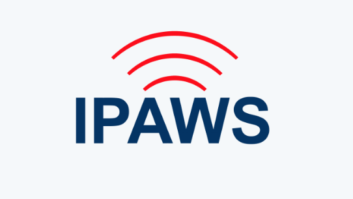About the Companies
(click thumbnail)IDC Block Diagram of Westwood One Transmission System
Westwood One, based in New York, provides approximately 150 news, sports, music, talk, entertainment programs, features and live events. Subsidiaries include Metro Networks/Shadow Broadcast Services. SmartRoute Systems manages traffic information centers for state and local departments of transportation, and markets traffic and travel content. Westwood One serves some 5,000 radio stations and is managed by CBS Radio.
International Datacasting Corp., headquartered in Ottawa, Canada, provides products for implementation of broadband wireless infrastructure networks used to distribute broadband multimedia data. The company delivers IP-based datacasting services via satellite and content distribution technologies. Products are used for radio and TV broadcast networks and other professional multimedia content distribution applications.The advertisers in our sports products — NFL, NCAA, NHL, golf — wanted the ability to regionalize their commercials by geographical area.
The decision was made back in the summer of 2005 to purchase and install satellite distribution equipment that would allow regionalization of those advertisements or copy — “copy splitting” — in time for the NFL football playoffs at the end of the year and the NCAA men’s basketball tournament in March.
We only needed to deploy in the top 50 markets, which required us to run a mixed system, continuing to operate the legacy Starguide system for all markets 50 and higher. The Starguide II system that Westwood One uses did not have the capability to do the copy splitting.
The timing of this decision gave us only a few months to decide on which system to select, purchase and deploy. Fortunately, we had been talking with all of the satellite vendors in anticipation of finding a replacement system for the Starguide II. When we were faced with the decision and short timeline, much of our research was done.
Desired features
We began by creating a list of what we expected to see in a new-generation receiver.
Ten years after the design and deployment of the first Starguide receivers, technology has come quite a long way. IP satellite transmission, new and more efficient audio algorithms, affordable high-density storage and broadband Internet are just a few of the things that are available to us that were just a dream 10 to 12 years ago. Those things were definite factors that influenced our design criteria.
Top on the list was to have the latest audio algorithm available and the ability to update the codec we use for transmission as needed.
With the Starguide, the system is locked into MPEG Layer 2 for transmission and only the bit rate is variable. Anything below 96 kbps per mono channel creates a noticeable degradation of the audio. AAC sounds much better at lower bit rates, making the system sound better and more bandwidth efficient. In addition, our tests with Ibiquity’s HDC codec show minimal transcoding effects using AAC.
Next, we needed the ability to send audio files to the receivers and play those files in place of the satellite stream (store and forward). This gives you the ability to do the copy split.
File storage in the form of a hard drive in the receiver to store long-form programs and commercials was a must. We also required an easy interface at the head end in order to manage which receivers stored and played that audio. It is no small feat to keep track of and manage what stations will play what audio. A user-friendly interface to program the copy splits was needed.
In addition, we needed a system that could trigger the splits without our producers of the sporting events having to think about or worry about doing anything.
A connection to a wide-area network and the Internet was a necessity in this age of digital file transfers. This would allow a station to access what was on the receiver’s hard drive via their own audio LAN. An additional feature we considered was allowing stations to trap and play back programs as they wished, similar to how people use a TiVo in their homes.
Monitoring and control of the receiver via a Web interface was needed to ease access to the device for programming or changing channels if it were stored in a rack room or at a tower site. We wanted the Internet connection to allow reporting back to the head end to confirm files were delivered and played successfully.
We envisioned the ability for the receiver to fail over to the Internet for program reception in the event the satellite signal was lost as well. Also, as the Internet quality of service (QoS) continues to improve to carry things like Voice over IP and other streaming applications, our new system needed the capability to transmit over the Internet.
We needed the ability for the receiver to have at least eight relay triggers per channel for station automation, as opposed to the two per channel we have on the Starguide. Most talk shows and station automation systems just need a station ID tone and a local commercial start tone. But for sports distribution, especially baseball, tones for end of game, rain delays and re-joins, more triggers are needed.
We wanted the option of having a receiver that would be able to do six simultaneous streams out at once. The challenge for the design of the new receiver is that all six streams also need to be able to copy split, inserting stored audio off the hard drive on any of those six streams.
A robust RF section in the receiver was necessary and one that would work well in the 2 degree spaced congested skies we’re dealing with now.
With HD Radio gaining ground, another important feature we needed is the ability to transmit program associated data (PAD) to our affiliate stations. PAD contains title and artist information for stations to transmit over their RBDS or HD data streams.
Remote control of the receiver needed to be able to be done by the front panel, through a Web interface and through a serial connection to be driven by an automation system.
Due diligence
We spoke with Wegener, Comstream, Starguide, X-Digital, ICP and IDC to see what hardware and head-end systems they had to offer, and got an idea of how much it would cost. We also spent a lot of time speaking to existing customers of these companies to get a sense of what had been deployed, how it worked and how well the support was.
Let me say that the companies mentioned have great products and true strengths in what they do. However, we had some very specific needs that needed to be met fast. While all were willing to design and modify their systems, we felt only one had a product that already met our needs; that was International Datacasting Corp.
IDC had already been working with National Public Radio on the design and deployment of a new system for NPRSS. A lot of the design considerations we wanted already were designed into IDC’s latest receiver, called the SuperFlex. The Datacast XD head-end system coupled with the SuperFlex receiver provided us with the features on our wish list.
One big challenge IDC helped us figure out was how to trigger the split copy to play during a live sporting event. Using metadata transmitted through the IP stream of the ENCO DAD32 system we use, IDC wrote an application that uses that metadata to tell the receivers to play the appropriate commercial.
Head-end installation
The head end consists of two full racks of equipment: audio encoders, multiplexor, IP encapsulator and satellite modem.
In order to make it easy for our existing affiliates to pick up the new carrier, we put up a carrier on the same transponder (15) on the same satellite (AMC-8). To do this, we combined the IDC system into the same uplink system that transmits our Starguide carrier.
Deployment
The biggest challenge we faced with the deployment of the new receivers was getting them installed and tested at the stations. We sent 75 receivers out to stations in mid-December of that year with hopes that we would be live with all stations for the Super Bowl.
We found that even though stations had installed the new receivers, they were still using the Starguides. Many stations don’t have full-time engineers on-site to do the installations. We had to assign a Westwood One staff member to contact all 75 stations, reach their engineer and stay in close contact with them through the installation process. Our satellite services person would answer installation questions or refer engineers to IDC in the case of more difficult problems, then ultimately run tests to confirm that the receivers worked.
Our system has been on the air now for over a year and has proven to work well and deliver to our expectations. The audio sounds great using the AAC algorithm. IDC just released to us the next generation of the SuperFlex, which has two audio streams out in a single-rack-unit space. We’ll be testing that at selected affiliate stations next.













